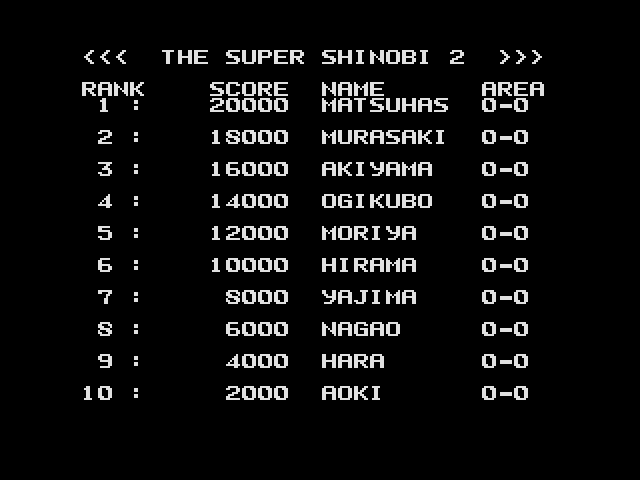User:GyroMan/November 1992 Shinobi III Proto
(Note: The Super Shinobi II is the Japanese name of Shinobi III, so it will be called "The Super Shinobi II" throughout this article.) A VERY early prototype of The Super Shinobi II, dated November 1992 in the header. At this point so early development, it's less a game and more a mishmash of assets; but it contains a lot of concepts, enemies, artwork, that isn't in any other version of the game, making it quite a treat to explore for those interested in what the game was going to look like before it was reworked.
To do:
|
| Download The Super Shinobi II (1192 Prototype)
File: The_Super_Shinobi_II_(1192_Prototype).zip (522 KB) (info)
|
Contents
Subpages
| Debug Menu The debug menu has many features that were removed in later builds of the game. |
| Sprites & Graphics A lot of the original art seems complete, but a lot of it ended up scrapped. |
| Levels The levels are in an extremely early state, and seem very slapped-together. |
Title Screen
| Proto | Final |
|---|---|
 |
 |
- The title screen is very early, using an earlier version of the Japanese logo and a simpler font.
- The copyright says 1992 instead of 1993.
- The text is aligned differently and Joe Musashi is not on the prototype's title screen.
Demo
- Throughout the demo in the prototype, there is no sound.
The order of events in the demo is different from the final.
| Proto | Final |
|---|---|
| Sega Logo > Opening Animation > Title Screen > Text Scroll > Demo > Leaderboard | Sega Logo > Title Card > Text Scroll > Opening Animation > Title Screen > Demos |
Opening Animation
| Proto | Final |
|---|---|
 |
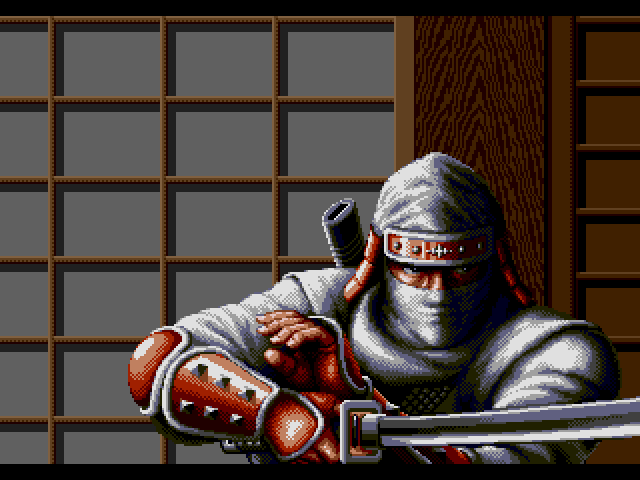 |
- The background uses a different palette and is slightly less detailed.
- Joe Musashi has been completely redrawn and given a different palette.
- Joe's eyes don't move before the kunais are thrown at him in the prototype.
| Proto | Final |
|---|---|
 |
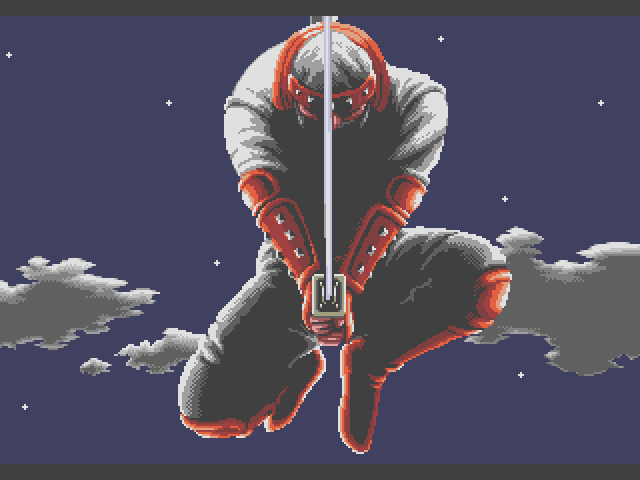 |
- There are no stars in the sky and the clouds are less detailed. The moon is more yellow and less detailed.
- Joe has once again been completely redrawn and given a different palette.
- Since there's no sound in the prototype's demo, his jumpkick sound doesn't play there.
| Proto | Final |
|---|---|
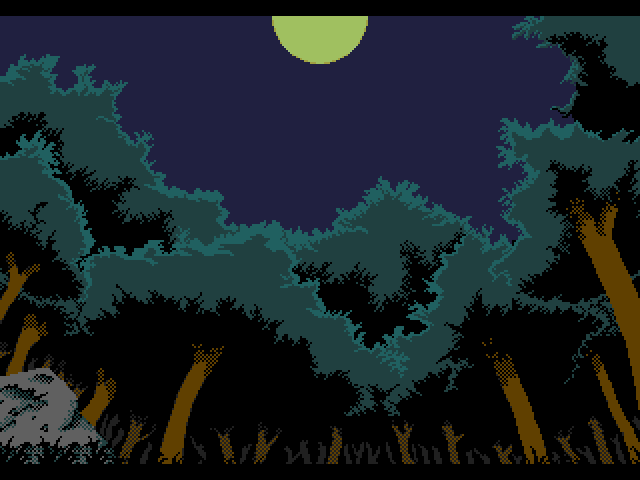 |
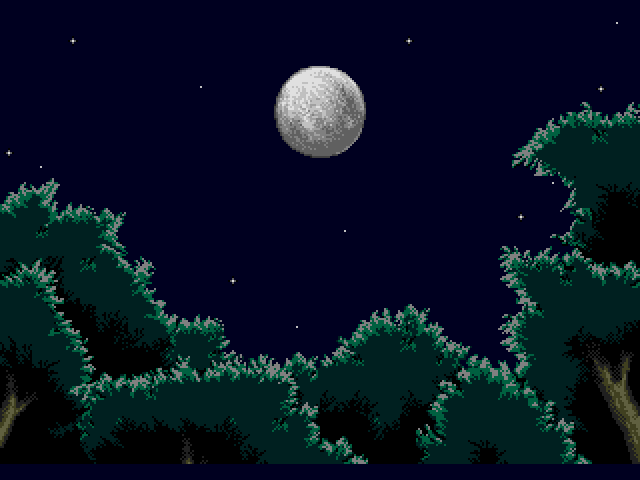 |
- The trees and moon have little to no detail in the prototype.
- In the prototype, it pans down slightly to show some shaded grass and a rock below. This doesn't happen in the final.
- There are no stars in the sky.
- The palette is different.
Text Scroll
| Proto | Final |
|---|---|
 |
 |
- The font is much less "handwritten".
- There's no background for the text.
The text is also very different from the final game.
| Proto | Final |
|---|---|
| Ninja... they are an indispensable shadow for secretly retrieving information or defense.
Moreover, the world of ninjas has in every epoch been divided in two forces. One is a wicked clan bent on ruling the world by means of dark power. The other is the good Oboro clan, restraining the evil clan and preserving the peace equilibrium. Neo Zeed. Threatening the world in the past, it was thought that this gigantic crime organization been crushed completely at the hands of the exceptionally gifted Joe Musashi from the Oboro clan. However, "Masked Ninja" - the leader of Neo Zeed - who had been defeated 2 years earlier, was only the puppet of the true leader "Shadow Master". And so, with Shadow Master as it's origin, Neo Zeed was reborn, taking the new name "Neo Ghost", and restarting it's activities. And in order to get rid of the nuisance Joe Musashi, they started to extend their evil influence to Ninja Village. |
'SHADOWS'
HE IS STRONGER THAN STEEL AND MOVES FASTER THAN A WHIRLWIND. SOMETIMES HE HIDES IN MUD. OTHER TIMES HE CHANGES HIS SHAPE LIKE AN EVER CHANGING CLOUD. ALTHOUGH HIS FIGHTING SPIRIT BURNS LIKE FIRE, HIS MIND IS AS CALM AS STILL WATER. 'VIOLATION OF THE COMMANDMENTS' SHOULD SHINOBI FAIL BEFORE COMPLETING THE MISSION, HE WILL DISAPPEAR BEFORE THE DAWN AND VANISH FOREVER. KEEP THIS KNOWLEDGE IN YOUR HEART AND MIND. --FROM THE 'SECRET MANUAL OF OBORO NINJITSU' |
Leaderboard
An evidently unfinished leaderboard that is unseen in any later versions of the game. The names seem to be the names of developers such as Tsukasa Aoki and Hirofumi Murasaki.[1]
Game Demo
The ingame "demo" in the prototype actually just spawns you in Round 1-1 with no music. You can control the player until the game eventually fades to the leaderboard. If you do an action that emits sound, it will make a sound.
Options Screen
The options menu is very basic at this point in development, using a generic grey box and black background instead of the final’s title screen darkened.
| Proto | Final |
|---|---|
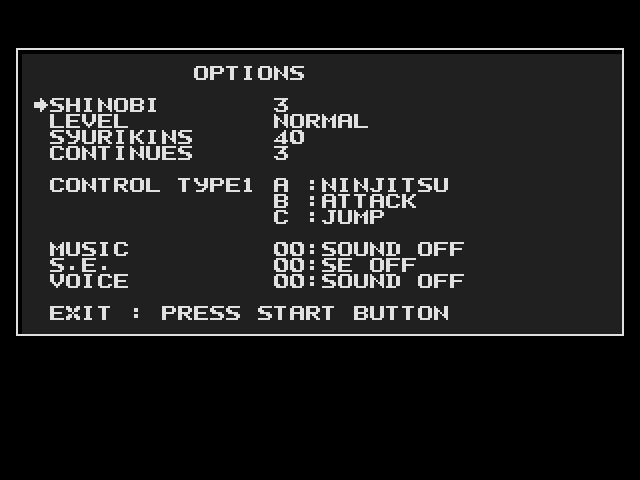 |
 |
SHINOBI: The amount of lives you start with. This option isn’t in the final game.
LEVEL: The level of difficulty. Doesn’t seem to do anything yet.
SYURIKINS: Changes your number of starting kunais. Notably, setting the number of kunais to 0 will instead give you a non-depleting supply of 999, A.K.A. infinite kunais. Starts on 40 instead of the final game’s 50.
CONTINUES: Changes your number of continues. This option isn’t in the final game.
CONTROL TYPE1/2/3/4: Switches which button does which.
MUSIC: Allows you to play (most) of the music in the game by selecting a track and pressing A. You can't make the music stop, even with the "SOUND OFF" option.
S.E.: Allows you to play sound effects in the game by selecting a sound and pressing A. The "SE OFF" option won't do anything.
VOICE: Allows you to play voices in the game by selecting a voice and pressing A. The "SOUND OFF" option, once again, won't work.
Hidden "Pazzle" Game
A puzzle game that can be accessed by selecting "EXIT : PRESS START BUTTON" and pressing A, B, or C. It's a lights-out type minigame where you must make all the orbs disappear. You can select an orb by pressing left or right and toggle its state and the orbs adjacent to it by pressing A. While in the puzzle, the song "Inner Darkside" plays in the background. After completing the puzzle, "He Runs" will play. After that, you can press A to restart the game. You can press start to exit at any time, but the music from the puzzle will keep playing.
Enemies
The prototype only has a handful of enemies in it, and all of them were reworked or scrapped entirely. Note that none of the appointed names for the enemies are official, so don’t take them too seriously.
Enemy Ninja
These enemy ninjas are fairly different from the final’s. Unlike the final enemy ninja, which just jumps in place and throws shurikens, this ninja is a lot more aggressive and will leap around the player, throwing shurikens while in the air. Colliding with the ninja will knock the player back, but won’t do any damage. Getting hit by a shuriken, however, will damage the player. If you hurt the ninja, it’ll jump back and teleport away.
Tiger
Probably the most well-known enemy that was scrapped, this tiger enemy slowly paces toward you until leaping forward to attack.
Grenadier
A crudely-animated enemy that waits a couple seconds before flinging a grenade toward the player. Their sprites are slightly glitched ingame, but can be reconstructed.
Muscular Cyborg
A bulky robot-like character with a couple of attacks. It can extend its arm forward to punch the player, but this can easily be ducked. When you’re close to the enemy (or jumping over it) it switches to a closer-ranged punch.
Flying Robot
A very obnoxious enemy that is thankfully used quite sparingly. It flies around the screen and will attack the player with numerous high-damage missiles. It also has much higher health than any other enemy in the prototype. On the bright side, you get a LOT of points for killing one, and in certain areas you can spawn in the enemy without it noticing you. If you can do this, you can just throw kunais at it until it dies.
Music
Quite a few songs in the final game don’t exist yet in this prototype, and the ones that do are for the most part very incomplete and/or different.
He Runs
An early version of He Runs, with different instruments and a prototype-exclusive section starting at around 2:30.
Ninja Soul
This early version of Ninja Soul has different instruments.
Shadows (Boss! Boss!)
An early version of Shadows, almost completely different from the final game. Called "Boss! Boss!" in the sound test.
Hassou (Hassou!!!)
Just like He Runs, the prototype version of Hassou has different instruments and a segment unseen in the final game starting at 0:43. Called "Hassou!!!" (note the exclamation marks!) in the sound test. Not used ingame.
Inner Darkside
Quite close to the final compared to the other songs in the prototype! There are still some unfinished areas in this version, though, like the section starting at around 1:05.
???
| To do: Instead of a youtube video, hack the song back in and rip it. The instructions are in the description of the video. |
Probably the most unique case of music in this prototype. This song cannot be heard without hacking, as it doesn't work in the soundtest (despite being listed) and doesn't play anywhere else.
Shinobi Walk
Same as the final except for different instruments.
Rush And Beat (Rush © Beat■Me)
Again, same song, different instruments. Called "Rush © Beat■Me" in the soundtest. Not used ingame.
Storm Wind (Map Da!)
Fairly similar to the final, only has minor differences.
Round Clear
Near identical to the final game with only minor differences.
Wabi (Ninja Lulubay)
Also very close to the final. Called "Ninja Lulubay" in the soundtest.
Sabi (Sakura)
Close, but slightly less complete. Called "Sakura" in the soundtest.
Yayoi
An energetic song unique to this prototype. Not used anywhere ingame, so it's not known what this song's purpose was meant to be.
Getufu (Ju Goya)
Basically identical to the final game. Called "Ju Goya" in the soundtest.
Sakura (The End)
An early version of Sakura with different instruments and a unique section starting around 0:46. Called "The End" in the soundtest.
Sounds
Gameplay Differences
This prototype has a number of differences with the playable character, Joe Musashi.
General Differences
- Pressing Down or Up will pan the camera in that direction.
- Your jump is slightly floatier.
- When crouching, kunais are fired slightly higher than in the final game, meaning they go over boxes even if the player and box are at the same height.
- There is no walljump in the prototype.
- The jumpkick (Down + B while in the air) has no forward movement by itself, and depends on your momentum when you activate it. You do not bounce off of enemies when you hit them with it, meaning you often jumpkick straight into the enemy and take damage.
Prototype-exclusive moves
- By holding C while clinging to a ceiling, the player will do a swinging animation. It doesn’t seem to serve any purpose.
- If you have a POW, your jumpkick is replaced with a downward sword slash.
- There’s an odd flip move with a tricky input. If you do Right, Downright, Down, Downleft, Left + C the player will do a janky backflip. It actually has a hitbox and can kill enemies.
Ninjitsu Differences
- A unique feature in this prototype can be found if you have a POW. If you’re “POWered up”, your ninjitsu will be stronger.
- Mijin is pretty barebones in this prototype. It doesn’t cost a life, but does cost your ninjitsu. It doesn’t restore health either. It will damage enemies, however. If you have a POW, it’s about the same except for some garbage sprites flying around after the animation ends.
- Kariu is an interesting case. The non-POW version has several fireballs spiral around the screen. The POW version’s animation is the same as the final game and does more damage.
- Ikazuchi’s non-POW version is fairly similar to the final game. The POW version has a different activation animation and allows you to tank more hits.
- Fushin seems about the same as the final game, POW or non-POW.
- There’s an entirely unique scrapped ninjitsu called Hakuriu. The non-POW version summons a giant ice ball above the player’s head. It can kill enemies, but the enemy has to be touching the ice. The POW version is fullscreen and makes ice dragons breeze through the screen and deal damage to enemies.
Other Differences
Oddities
Crouch Block Sprite
| To do: Test on some other emulators and a real genesis. |
While sitting still and crouch blocking, the player’s sprite can glitch, but only on certain emulators. In Gens, the crouch blocking sprite is normal. In some newer emulators like Blastem, however, the sprite is glitched. The reasons why are currently unknown.
| Gens | Kega Fusion / Blastem |
|---|---|
| File:Placeholder | File:Placeholder |
Unused Graphics
Muscular Cyborg Enemy
There are a couple of unused frames for the cyborg enemy.
Unused 1-1 Tiles
By using the level editor in the debug menu, you can place these unused tiles if you’re in Round 1-1 or 1-2. They have no collision. It isn’t very easy to figure out what these could’ve been used for; perhaps a crate or bridge?
When put together, the tiles look like this.

